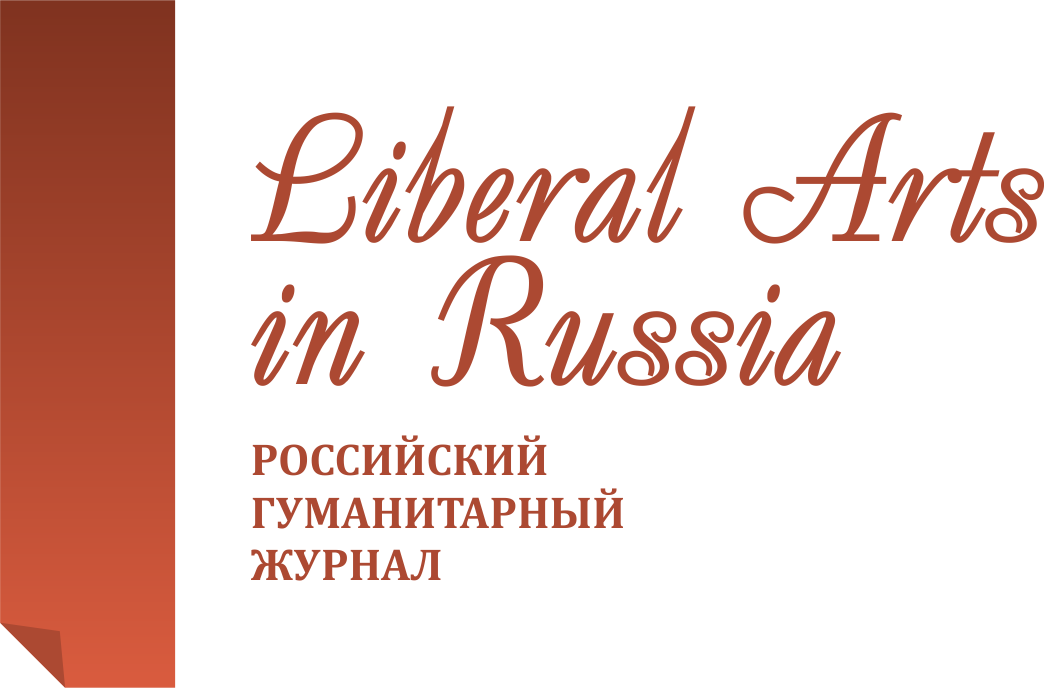Guide for Authors
INTRODUCTION
The scope of Liberal Arts in Russia embraces philosophy, linguistics, literary studies, art history and Arts, pedagogy and education theory, psychology, ethics and aesthetics, cultural studies, ethnology, religion, history, history and philosophy of science, history and theory of art, sociology and journalism.
Languages of publication. Liberal Arts in Russia publishes articles in English, Russian, Czech, Slovak, Polish, Bulgarian, Ukrainian.
Types of paper. Regular papers. Original full-length research papers which have not been published previously may be submitted as regular papers. There is no standard for the length of articles, provided that they are interesting and original, even very long articles may be accepted.
PREPARATION
The first page should be the title page containing full title and author’s name, postal address and e-mail address. In case of a Russian author’s name, please indicate the desired transcription; if not the editors will use the BS 2979:1958 transliteration.
Liberal Arts in Russia uses the BS 2979:1958 transliteration of Cyrillic. Please use this transliteration consistently throughout the article.
The manuscript should provide the following information:
• Title. Concise and informative. Avoid abbreviations and formulae where possible.
• Authors’ names and affiliations. Present the authors’ affiliation addresses (where the actual work was done) below the names. Indicate all affiliations with a lower-case superscript number after the author’s name and in front of the appropriate address. Provide the full postal address of each affiliation, including the country name.
• Corresponding author’s e-mail.
Abstract
An abstract should be given both in English and in Russian. It is often presented separately from the article, so it must be able to stand alone. For this reason, abstract should contain title, authors’ names and affiliations, corresponding author’s e-mail equal to stated in the manuscript.
References should be avoided, but if essential, then cite the author(s) and year(s). Also, non-standard or uncommon abbreviations should be avoided, but if essential they must be defined at their first mention in the abstract itself.
The abstract should state in a brief resume (150–300 words) the purpose of the research, the principal results and major conclusions.
The resume is followed by keywords; no more than 10 words or word combinations.
Text of the Article
There are no special requirements for font type or text format.
Tables, figures, graphs, formulas
Table should have title, explaining its contents.
Number tables consecutively in accordance with their appearance in the text. Place footnotes to tables below the table body and indicate them with italic bold superscript lowercase letters. Be sparing in the use of tables and ensure that the data presented in tables do not duplicate results described elsewhere in the article.
Figure caption is located under it and must contain a clear explanation, designations, numbers of curves and graphs.
Each figure or table must be referred to by its number at least once in the manuscript text.
Figures and photos should be as clear as possible (preferably in colour, but it should be possible to make them monochrome without loss of semantic content ) and presented in .jpg format.
For graphs and diagrams Microsoft Office Excel should be used with and Microsoft Equation for mathematical formulas.
The number of mathematical formula is given to the right of the formula in italics in parentheses, for example: (5).
References in text
References are given by numbers in brackets, for example: [1]. If it is necessary to specify the page, its number is listed after the reference number separated with comma: [1, p. 223].
Reference to columns in handbooks, dictionaries, etc. denoted by [1, col. 1311].
The numbering of the references should be listed in order of their appearence in the text or in alphabetical order.
Literary source in the reference list is specified once (unique number is assigned and used throughout the text of the publication).
Acknowledgments (optional).
Acknowledgments of financial assistance for the conduct of research, citations of theses, or indications of presentation at a research meeting should be brief and placed in this section.
References
References should be enlisted according to the chosen numbering (in order of appearence in the text or in alphabetical order).
Names of periodicals should be followed by year, volume and issue numbers, and by the article’s page numbers:
1. Tertytchny A. A. Genre Formatting in Periodic Printed Media of Russia // Liberal Arts in Russia. 2013. Vol. 2. No. 2. Pp. 117–128.
Titles of books should be followed by place, publisher and year of publication:
2. Sadler P., Ethier N., Woody W. Interpersonal complementarity // Handbook of interpersonal psychology: theory, research, assessment and therapeutic interventions / Ed. L. W. Horowitz, S. Strack. Hoboken, New Jersey: Wiley, 2011. Pp. 123–143.
Website links should be marked as URL: before the link:
3. The American Middle Class Is No Longer the World’s Richest. The New York Times. 2014. URL: http://www.nytimes.com/2014/04/23/upshot/the-american-middle-class-is-no-longer-the-worlds-richest.html?ref=economy
